Desktop Ivy Bridge. Intel Core i7-3770K and Core i5-3570K Processors Review

A year and a half after the launch of the LGA 1155 platform Intel is updating its key component – the CPU. The new manufacturing process, improved microarchitecture and refreshed lineup – is it the coming of a new star?
Every review about Intel’s new CPUs is supposed to begin with the tick-tock rule and how it applies to them. One may even get a notion that Intel is indeed following this empirical law for some mysterious reason. But the fact is that the development and introduction of new CPU microarchitectures and manufacturing technologies comply with other rules. The rules and laws of business. So, the tick-tock model is just a suitable illustration of technical progress which seems to reflect the reality more or less accurately.
Well, it doesn’t anymore. The release of the Ivy Bridge series is supposed to be a “tick”, just a transition of the older Sandy Bridge microarchitecture to new 22nm tech process, but the new CPUs actually sport a lot of other changes. Intel refers to the Ivy Bridge as a “tick+” phase but the new series could be a “tock” just as well.
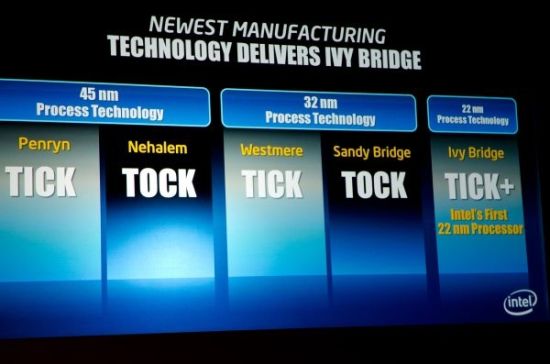
Any action taken by a CPU maker is supposed to have two ultimate goals: promote its products and reduce their manufacturing cost. Basing on this fact, rather than on some abstract rules, we can easily understand the purpose of the Ivy Bridge series.
Being the leader of the CPU market, Intel’s sales volumes are many times those of its closest competitors. So, the only way for Intel to keep on expanding is to reach into new markets. Currently, the most perspective products are the slim and light mobile computers of the tablet PC and ultrabook classes, and it’s in this direction that Intel has been refocusing. The Ivy Bridge series is supposed to hit right at this mobile computer market and compete with other popular platforms such as the ARM architecture and AMD’s hybrid x86 CPUs of the Zacate, Llano and Trinity series. Intel’s new CPUs can only be successful in this competition if they add a high-performance integrated graphics core and low heat dissipation to their traditionally high computing performance. And while the energy efficiency problem can be solved by introducing new manufacturing technologies, it takes some more effort to improve the graphics which has never been a strong point of Intel’s CPUs. This explains why Intel had to introduce significant changes into the Ivy Bridge microarchitecture and break the tick-tock rule.
Although optimized for ultra-mobile solutions, the Ivy Bridge is declared to be versatile and such CPUs are going to be used not only in mobile but also in desktop and even server computers. There’s nothing wrong about that since their computing part hasn’t changed much since the Sandy Bridge while the new tech process can help achieve higher clock rates and related performance benefits.
In this review we are going to take a look at the Ivy Bridge microarchitecture and CPUs from a standpoint of desktop users. Although the higher performance and wider functionality of the integrated graphics can hardly matter for the larger part of this consumer category, the Ivy Bridge can be interesting for them anyway. The new 22nm tech process may increase the CPU’s performance per watt and improve its frequency potential. That’s already enough for the Ivy Bridge to be more attractive than the Sandy Bridge series in the eyes of demanding enthusiasts.
Brief Overview of Ivy Bridge Microarchitecture
Although we’ve said that the Ivy Bridge microarchitecture has some significant differences from its predecessor Sandy Bridge, it’s very easy to see that they are closely related to each other. There are in fact no differences at the very top level of the overall CPU structure. The improvements are in small details. You can refer to our special report for a detailed description of the innovations. We’ll just glance over the key points here.
First of all, the Ivy Bridge series doesn’t change the platform. These CPUs are installed into the same LGA1155 socket as their predecessors and are fully compatible with existing mainboards. Intel has recently rolled out its 7 series chipsets, spearheaded by the Z77 model, but you don’t really need a mainboard with the new chipset to use an Ivy Bridge CPU. Like the Sandy Bridge series, the Ivy Bridge employs a 20Gbps DMI 2.0 bus. So again, the new CPUs will work problem-free on any LGA1155 mainboard.
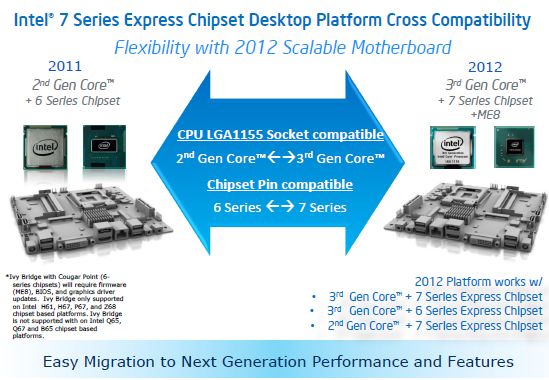
Ivy Bridge processors have the same functional subunits as their Sandy Bridge predecessors: two or four cores equipped with individual 256KB L2 caches; an integrated graphics core; up to 8 megabytes of shared L3 cache, a dual-channel controller of DDR3 SDRAM; a controller of the graphics PCI Express bus; and a system agent responsible for the Turbo technology and auxiliary interfaces. Every component of an Ivy Bridge CPU is linked to a ring bus, just like in a Sandy Bridge.
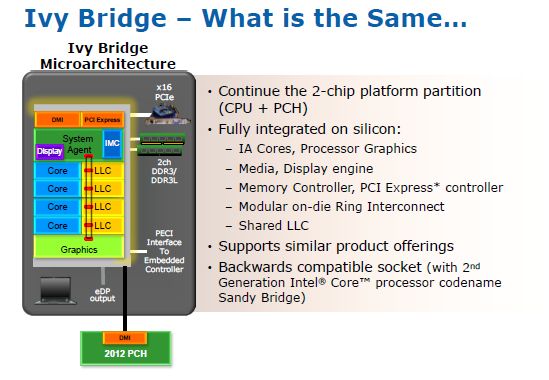
The key difference of Ivy Bridge CPUs from their predecessors is the new 22nm manufacturing process. Besides being “thinner”, the transistors have a different internal design. Intel calls it tri-gate, which implies the use of a tall silicon fin cutting through the gate and coated with High-K dielectric.
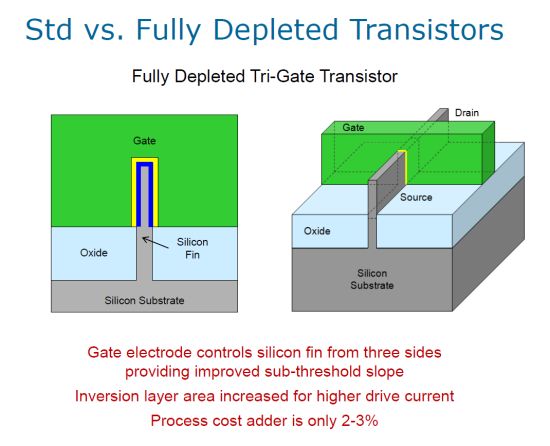
As a result, semiconductor devices with tri-gate transistors can work at lower voltage and dissipate less heat. According to the official datasheet, the Ivy Bridge enjoys a 50% advantage over the Sandy Bridge in terms of performance per watt.
The increased energy efficiency is most welcome considering that one of the most purposes of the Ivy Bridge series is their massive use in ultra-mobile computers. To reinforce the effect, Intel engineers have introduced new power-saving technologies: deeper sleep states, the option of powering down the memory controller, support for low-voltage DDR3L SDRAM, and the so-called configurable TDP. As a result, the numerous Ivy Bridge modifications include a whole class of ULV products with a TDP of 17 watts that can be further lowered to 14 watts.
The new manufacturing technology means smaller semiconductor dies. The die of a quad-core Ivy Bridge is 160 sq. mm or 35% smaller than a quad-core Sandy Bridge.
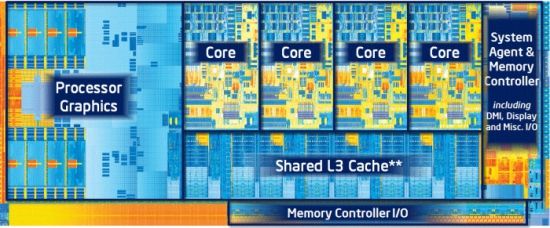
Despite that, the new CPU incorporates 1.4 billion transistors as opposed to the predecessor’s 995 million.

The additional transistors are usually utilized for cache memory but not in the Ivy Bridge CPUs which have the same L1, L2 and L3 caches as the Sandy Bridge. So, this time around, the extra transistors can mostly be found in the integrated graphics core. It is almost a totally different thing from the previous-generation Intel HD Graphics 3000/2000.

The HD Graphics 4000 core is up to today’s requirements and standards. It complies with DirectX 11 (DirectCompute and Shader Model 5.0) and supports GPGPU via OpenCL 1.1. The HD Graphics 4000 supports up to three displays while its performance has been improved by increasing the number of execution devices from 12 to 16. That’s why Intel expects more computers with Intel CPUs to be used without a discrete graphics card, mostly in the mobile market segment.
The integrated graphics isn’t so important for desktop users, though. They want higher performance from the new CPUs as regards pure computing. Unfortunately, the Ivy Bridge series can’t offer much in this respect. Clocked at the same frequency, an Ivy Bridge is only expected to be some 5% faster than a Sandy Bridge. The execution cores have remained largely intact in the new microarchitecture with but a few minor improvements. To be specific, the Ivy Bridge is somewhat faster in terms of integer and floating-point division. The speed of data transfers between registers has been improved, too. The static distribution of internal buffer resources between different instruction threads for Hyper-Threading is now replaced with dynamic distribution.
To check out the practical benefits of these changes we ran the synthetic tests from the SiSoft Sandra benchmark. They implement simple algorithms and allow to evaluate the performance of a CPU at different types of operations. As a preliminary test, we compared quad-core Sandy Bridge and Ivy Bridge CPUs clocked at 4.0 GHz with Hyper-Threading disabled.
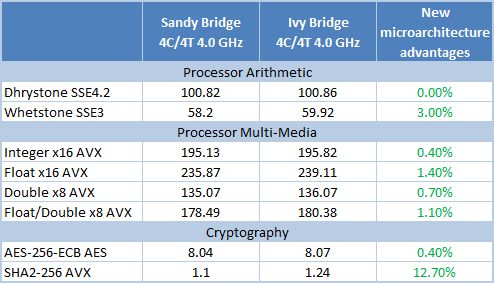
Indeed, the minor improvements in the execution core design can hardly be observed in the performance tests.
The different kind of improvements – those concerning the memory and PCI Express bus – may turn out to be more interesting, though. The PCI Express controller integrated into the Ivy Bridge supports the third version of the bus, which means a twofold increase bandwidth compared to PCI Express 2.0 – up to 8 GT/s.
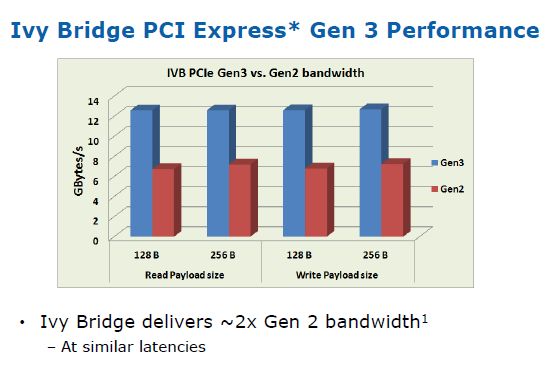
The 16 PCI Express lanes supported by the Ivy Bridge can be split up in two or three groups: 8x+8x or 8x+4x+4x. The latter variant may be interesting for triple-GPU configurations especially as PCI Express 3.0 is quite capable of providing the required bandwidth even via 4 lanes.
As for the memory controller, its key specs haven’t changed since the Sandy Bridge series. It still supports dual-channel DDR3 SDRAM but has been enhanced in terms of frequencies. The top frequency it supports is now DDR3-2800 SDRAM and you can use change the clock rate using a step of 200 or 266 MHz.
The actual performance of the memory controller has changed somewhat, too. We can see that in benchmarks. Take a look at the results of AIDA64 Cache & Memory Benchmark on Sandy Bridge and Ivy Bridge CPUs clocked at 4.0 GHz.
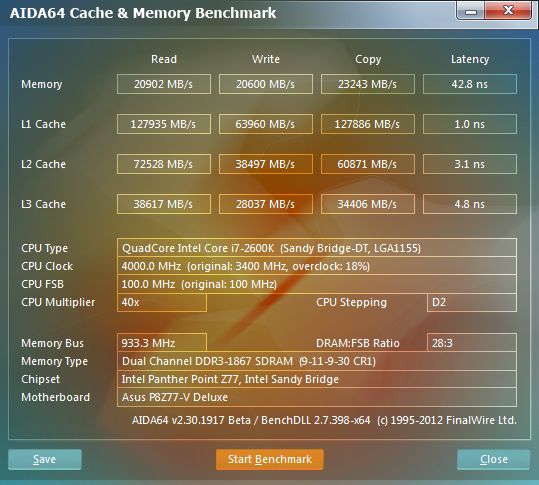
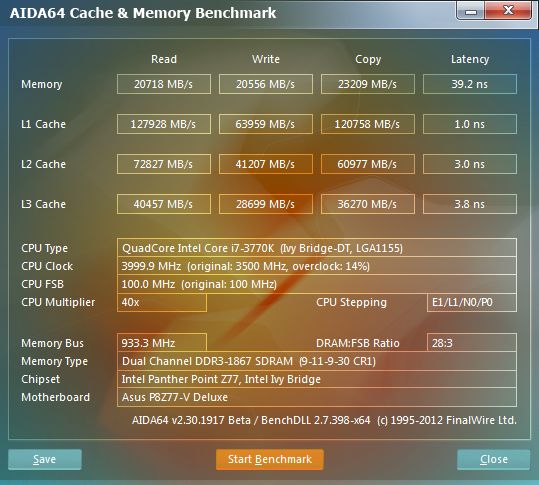
The Ivy Bridge is somewhat better in terms of practical memory latency, but its advantage is negligible. The benchmark reveals another fact: the new CPUs seem to have a faster L3 cache. Well, this is not really so. The difference is due to the speed of execution of the benchmark instructions. As a matter of fact, the L3 cache latency is 24 cycles with the Ivy Bridge, which is 1 cycle more than with the Sandy Bridge. In other words, the L3 cache has got somewhat slower in the new CPUs but you can hardly observe this in practical applications.
Ivy Bridge Model Lineup
The Ivy Bridge series doesn’t seem quite attractive for desktop users so far. Apart from the new-generation integrated graphics core, the only notable innovations are PCI Express 3.0 and reduced heat dissipation. The Ivy Bridge cannot offer higher computing performance. It can’t do more instructions per clock than its predecessor. This didn’t prevent Intel from using 3000 series numbers for the new products, though. The Ivy Bridge series is positioned as a replacement for the Sandy Bridge and is expected to steadily drive the latter out from the market.
It must be noted that the Ivy Bridge release isn’t as massive as the January 2011 launch of the Sandy Bridge. The new 22nm tech process gave rise to certain manufacturing problems, so the new generation of CPUs will come out gradually. Today Intel only rolls out the quad-core modifications: mobile and desktop Core i7 and desktop-only Core i5.
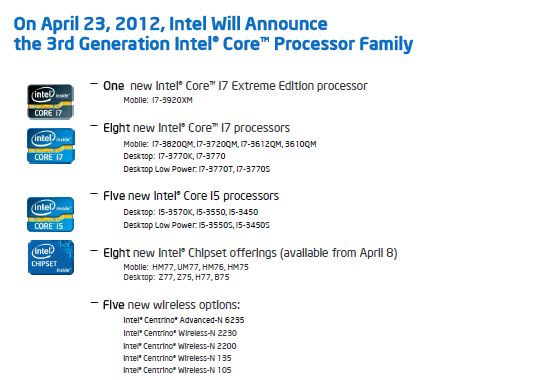
The rest of the Ivy Bridge series will be released in small groups throughout this year.
So, we are interested in desktop-oriented CPU models. They are nine in total, four of them being energy efficient. The following table lists all desktop Ivy Bridge CPUs which will be available in shops starting from the next week:
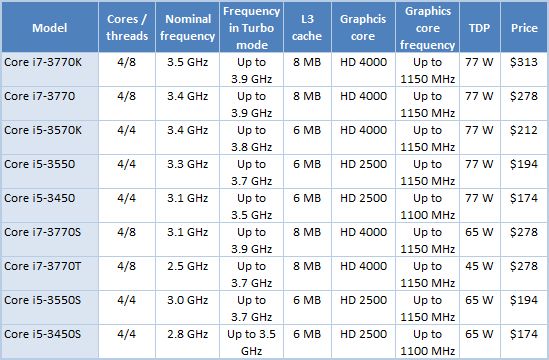
The first thing we can see in the specs of the new CPUs is the reduced TDP of the top models. The fastest Sandy Bridge processors had a TDP of 95 watts while their Ivy Bridge counterparts, only 77 watts. This is the result of the new manufacturing process. Unfortunately, the clock rate of the new CPUs is lower than 3.5 GHz which is the frequency of the older Core i7-2700K. So, it turns out that we can only expect increased performance from the economical models which have the same TDP but higher clock rates compared to the previous generation. The ordinary CPUs offer a better performance/watt ratio but not higher clock rates. So, once again we are reminded of the fact that the key feature of the new CPUs is their improved graphics core which is available in maximum configuration in any Core i7 as well as in the senior Core i5 model.
Fortunately, the Ivy Bridge has something to offer for desktop systems with discrete graphics, too. For the new CPUs to be faster in practical applications, Intel has re-tuned its Turbo Boost technology. The frequency range being the same, the automatic CPU overclocking is more aggressive now. The clock rate can be increased by 200 MHz even when all of the CPU cores are under load. That’s why the new CPUs are faster than their older counterparts with the same specs in most benchmarks.
Testbed Configuration
To test the new Ivy Bridge processors from Intel we got our hands on two units: the top Core i7-3770K model in the lineup and a “simpler” modification – Core i5-3570K.
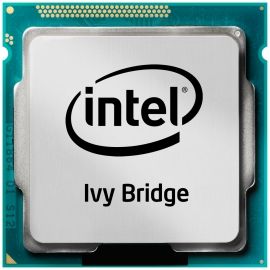
These newcomers will be competing against older LGA 1155 CPUs from the same class that belong to the Sandy Bridge generation: Core i7-2700K and Core i5-2500K. Moreover, we also included higher-end products – LGA 2011 Sandy Bridge-E processors: Core i7-3930K and ?ore i7-3820. And following more of a tradition than necessity we also included the top AMD CPU – AMD FX-8150.
As a result, our testbeds were configured using the following software and hardware components:
- Processors:
- AMD FX-8150 (Zambezi, 8 cores, 3.6-4.2 GHz, 8 MB L3);
- Intel Core i5-2500K (Sandy Bridge, 4 cores, 3.3-3.7 GHz, 6 MB L3);
- Intel Core i5-3570K (Ivy Bridge, 4 cores, 3.4-3.8 GHz, 6 MB L3);
- Intel Core i7-2700K (Sandy Bridge, 4 cores + HT, 3.5-3.9 GHz, 8 MB L3);
- Intel Core i7-3770K (Ivy Bridge, 4 cores + HT, 3.5-3.9 GHz, 8 MB L3);
- Intel Core i7-3820 (Sandy Bridge-E, 4 cores + HT, 3.6-3.9 GHz, 10 MB L3);
- Intel Core i7-3930K (Sandy Bridge-E, 6 cores + HT, 3.2-3.8 GHz, 12 MB L3).
- Processor cooler: NZXT Havik 140;
- Mainboards:
- ASUS Crosshair V Formula (Socket AM3+, AMD 990FX + SB950);
- ASUS P8Z77-V Deluxe (LGA1155, Intel Z77 Express);
- ASUS Rampage IV Formula (LGA2011, Intel X79 Express).
- Memory:
- o 2 x 4 GB, DDR3-1866 SDRAM, 9-11-9-27 (Kingston KHX1866C9D3K2/8GX);
- 4 x 4 GB, DDR3-1866 SDRAM, 9-11-9-27 (2 x Kingston KHX1866C9D3K2/8GX).
- Graphics card: EVGA GeForce GTX 580 Classified 3 GB (03G-P3-1588-AR);
- Hard drive: Intel SSD 520 240 GB (SSDSC2CW240A3K5).
- Power supply unit: Tagan TG880-U33II (880 W).
- Operating system: Microsoft Windows 7 SP1 Ultimate x64.
- Drivers:
- AMD Chipset Driver 12.3;
- Intel Chipset Driver 9.3.0.1019;
- Intel Management Engine Driver 8.0.0.1399;
- Intel Rapid Storage Technology 11.1.0.1006;
- NVIDIA GeForce 296.10 Driver.
When we tested the AMD FX-8150 based system we installed KB2645594 and KB2646060 OS patches.
Performance
General Performance
As usual, we use Bapco SYSmark 2012 suite to estimate the processor performance in general-purpose tasks. It emulates the usage models in popular office and digital content creation and processing applications. The idea behind this test is fairly simple: it produces a single score characterizing the average computer performance.
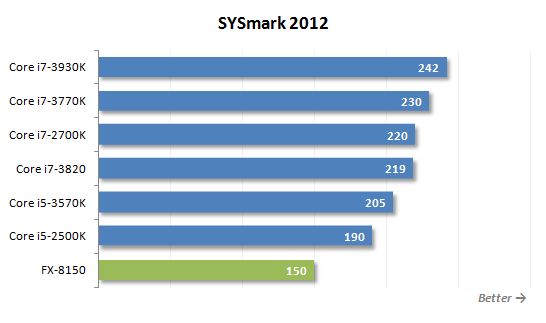
The Ivy Bridge is a step forwards in terms of performance, even though a small one. The Core i7-3770K is 4-5% faster than the quad-core Core i7 Sandy Bridge CPUs. The Core i7-3750K is 7-9% ahead of the Core i5-2500K. Besides microarchitecture improvements, this advantage is due to the higher clock rate. The new CPUs feature a more aggressive implementation of the Turbo Boost technology which increases their frequency by 200 rather than 100 MHz at full load.
Let’s take a closer look at the performance scores SYSmark 2012 generates in different usage scenarios. Office Productivity scenario emulates typical office tasks, such as text editing, electronic tables processing, email and Internet surfing. This scenario uses the following applications: ABBYY FineReader Pro 10.0, Adobe Acrobat Pro 9, Adobe Flash Player 10.1, Microsoft Excel 2010, Microsoft Internet Explorer 9, Microsoft Outlook 2010, Microsoft PowerPoint 2010, Microsoft Word 2010 and WinZip Pro 14.5.
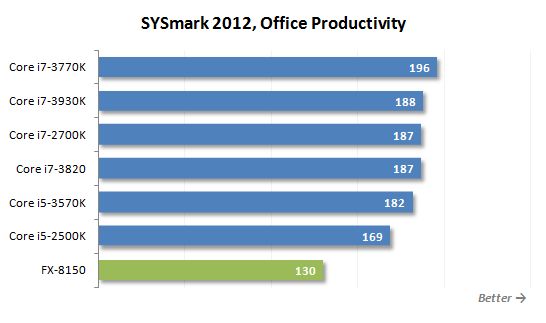
Media Creation scenario emulates the creation of a video clip using previously taken digital images and videos. Here they use popular Adobe suites: Photoshop CS5 Extended, Premiere Pro CS5 and After Effects CS5.
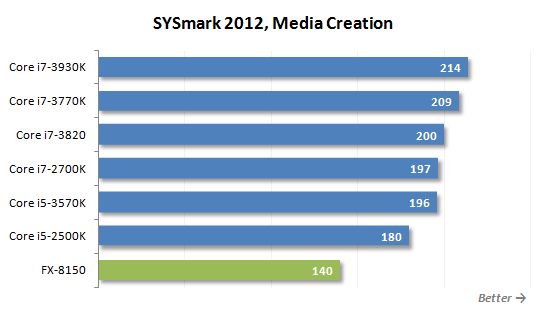
Web Development is a scenario emulating web-site designing. It uses the following applications: Adobe Photoshop CS5 Extended, Adobe Premiere Pro CS5, Adobe Dreamweaver CS5, Mozilla Firefox 3.6.8 and Microsoft Internet Explorer 9.
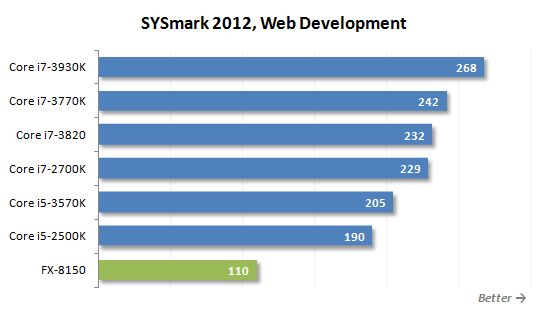
Data/Financial Analysis scenario is devoted to statistical analysis and prediction of market trends performed in Microsoft Excel 2010.
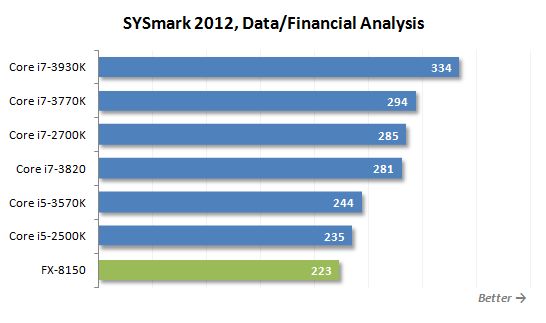
3D Modeling scenario is fully dedicated to 3D objects and rendering of static and dynamic scenes using Adobe Photoshop CS5 Extended, Autodesk 3ds Max 2011, Autodesk AutoCAD 2011 and Google SketchUp Pro 8.
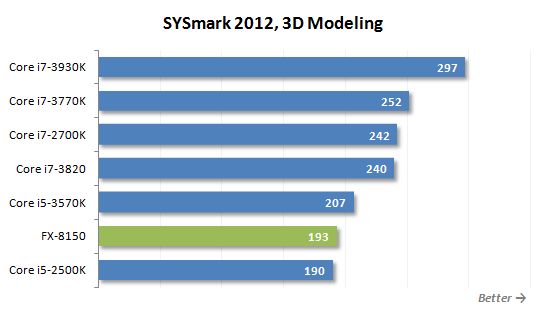
The last scenario called System Management creates backups and installs software and updates. It involves several different versions of Mozilla Firefox Installer and WinZip Pro 14.5.
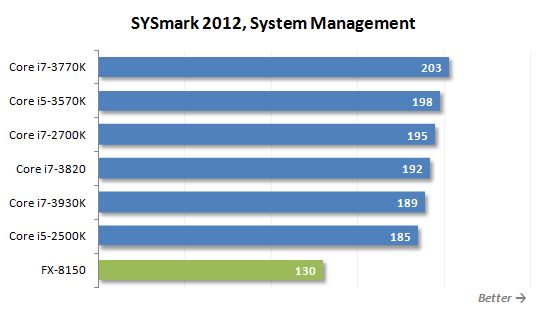
Take note that the Ivy Bridge CPUs look good at any load and seem to have no weak spots in comparison with the Sandy Bridge series. Well, where could such weak spots spring from? Their execution cores, memory controller and cache memory duplicate the Sandy Bridge microarchitecture with but minor optimizations which are reflected in the performance charts.
Gaming Performance
As you know, it is the graphics subsystem that determines the performance of the entire platform equipped with pretty high-speed processors in the majority of contemporary games. Therefore, we do our best to make sure that the graphics card is not loaded too heavily during the test session: we select the most CPU-dependent tests and all tests are performed without antialiasing and in far not the highest screen resolutions. In other words, obtained results allow us to analyze not that much the fps rate that can be achieved in systems equipped with contemporary graphics accelerators, but rather how well contemporary processors can cope with gaming workload. Therefore, the results help us determine how the tested CPUs will behave in the nearest future, when new faster graphics card models will be widely available.
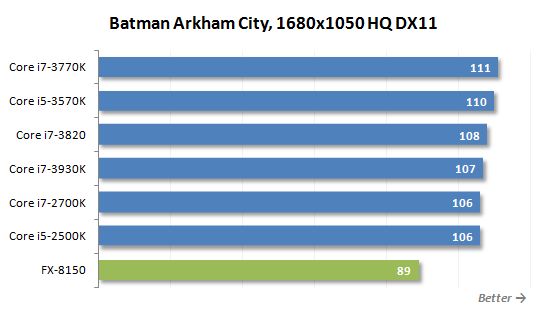
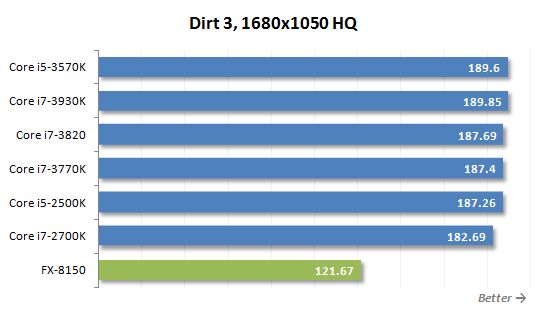
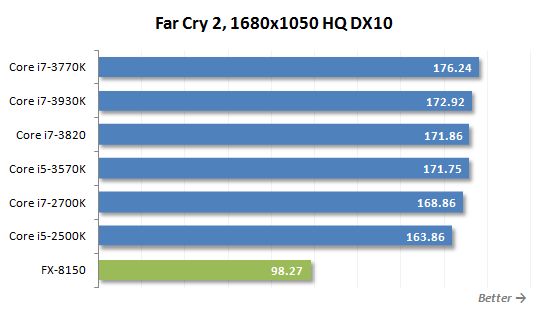
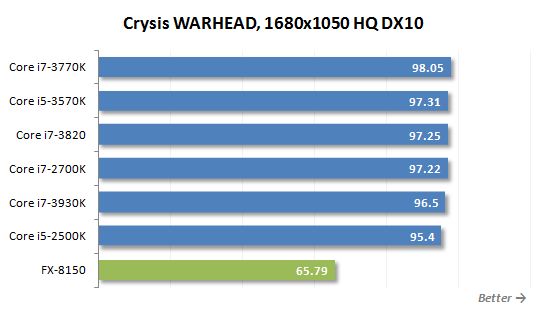
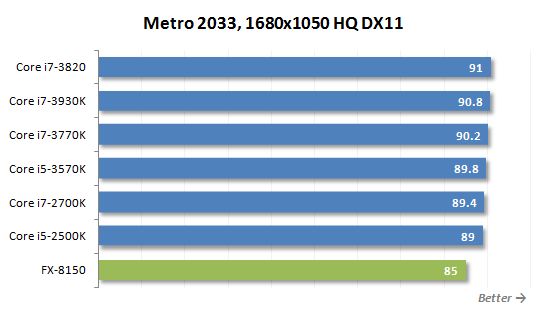
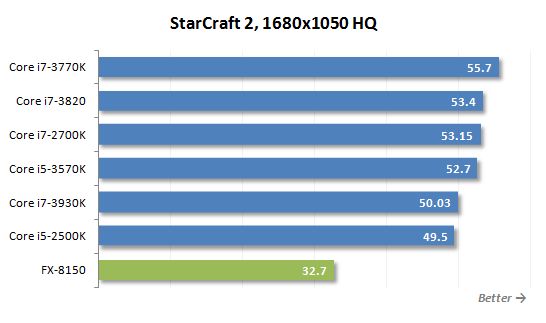
Frankly speaking, Intel’s flagship CPUs are very close to each other in modern games. They are too fast for today’s game engines, so the frame rate is usually limited by the graphics subsystem performance. Anyway, we can note that the Ivy Bridge series enjoys a small advantage, within 5%.
In addition to our gaming tests we would also like to offer you the results of the Futuremark 3DMark11 benchmark (Performance profile):
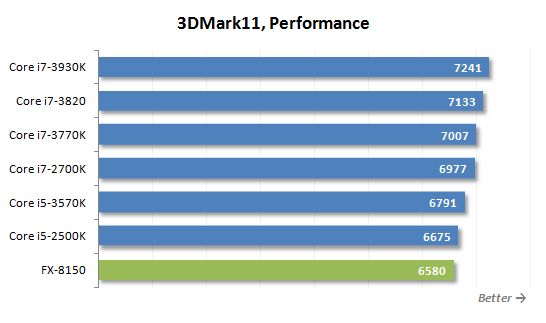
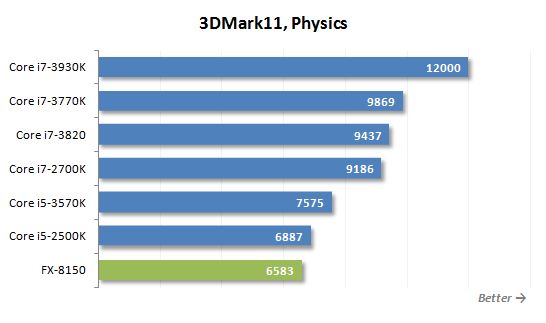
We can also note the benefits of the LGA2011 platform with its quad-channel memory but the Ivy Bridge series with its minor architectural improvements wins in the physics test.
Performance in Applications
We’ve found out already that we can’t expect performance breakthroughs from the Ivy Bridge series. It can only offer small performance benefits compared to the previous series unless we take into account its integrated graphics core which we are going to cover in an upcoming review. Well, let’s just see what the Core i7-3770K can offer in various resource-consuming applications.
To test the processors performance during data archiving we resort to WinRAR archiving utility. Using maximum compression rate we archive a folder with multiple files with 1.4 GB total size.
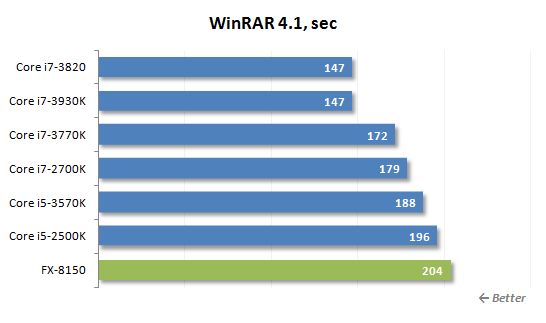
As can be expected from a new product, the Core i7-3770K is a little faster than the Core i7-2700K at archiving but the quad-core Sandy Bridge-E for the LGA2011 platform is considerably faster thanks to its larger L3 cache and quad-channel memory controller.
We use Apple iTunes utility to test audio transcoding speed. It transcodes the contents of a CD disk into AAC format. Note that the typical peculiarity of this utility is its ability to utilize only a pair of processor cores.
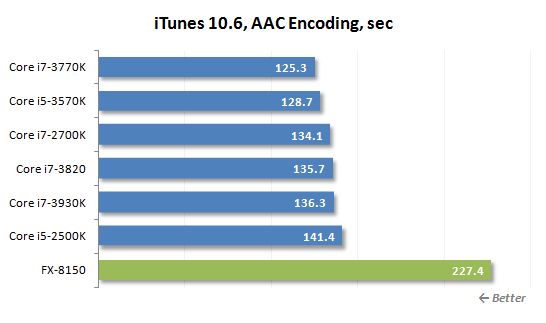
The Core i7-3770K is 7-8% ahead of the Core i7-2700K and Core i7-3820 whereas the Core i5-3570K beats the Core i5-2500K by about 10%.
We measured the performance in Adobe Photoshop using our own benchmark made from Retouch Artists Photoshop Speed Test that has been creatively modified. It includes typical editing of four 10-megapixel images from a digital photo camera.
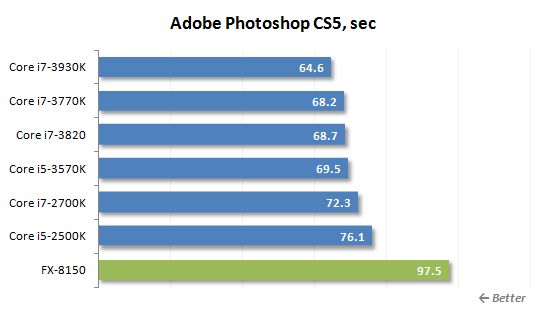
The new microarchitecture ensures the expected performance benefits in Photoshop CS5, so the Core i7-3770K is as fast as the Core i7-3820 while the Core i5-3570K overtakes the Core i7-2700K, a higher-class CPU of the previous generation.
Now that the eighth version of the popular scientific Mathematica suite is available, we decided to bring it back as one of our regular benchmarks. We use MathematicaMark8 integrated into this suite to test the systems performance:
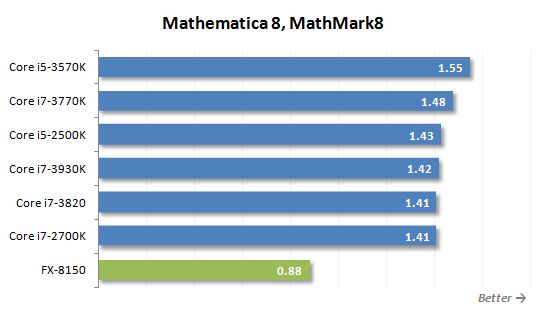
The Core i7-3770K is the same 5% ahead of the Sandy Bridge Core i7 in this test, too. The Core i5-3570K beats the Core i5-2500K by almost 8%. It is the 100 MHz higher clock frequency that saves the day for the newcomer in this test.
The performance in Adobe Premiere Pro is determined by the time it takes to render a Blu-ray project with a HDV 1080p25 video into H.264 format and apply different special effects to it.
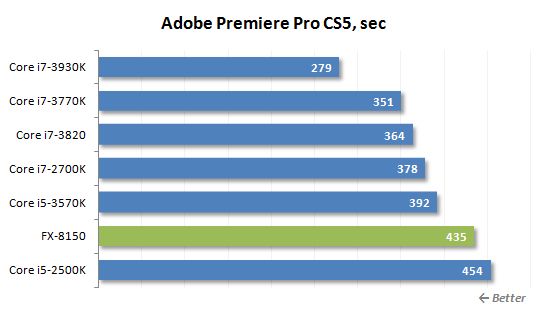
Work with video content is a type of task that allows Ivy Bridge to really shine and show its potential best of all. Core i7-3770K is almost 8% ahead of Core i7-2700K, and Core i5-3570K is as much as 16% faster than the same-class Core i5-2500K.
In order to measure how fast our testing participants can transcode a video into H.264 format we used x264 HD Benchmark 4.0. It works with an original MPEG-2 video recorded in 720p resolution with 4 Mbps bitrate. I have to say that the results of this test are of great practical value, because the x264 codec is also part of numerous popular transcoding utilities, such as HandBrake, MeGUI, VirtualDub, etc.
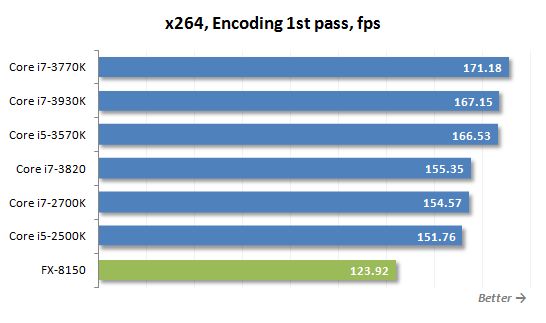
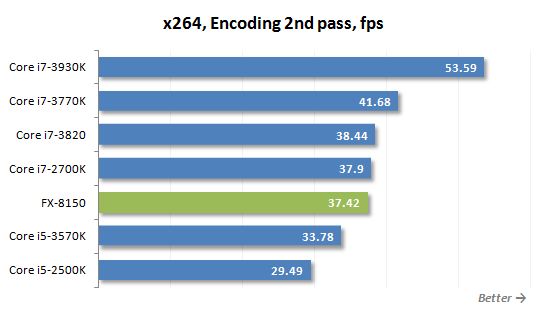
The x264 transcoding test produces the same results as the previous benchmark. The Ivy Bridge series enjoys a 10-15% advantage over the second-generation Core CPUs.
Following our readers’ requests, we’ve added a new HD video benchmark to our tests. SVPmark3 shows the computer performance in the SmoothVideo Project application which makes videos smoother by adding new intermediary frames. The numbers in the diagram reflect the speed of processing Full HD videos without the graphics card’s help.
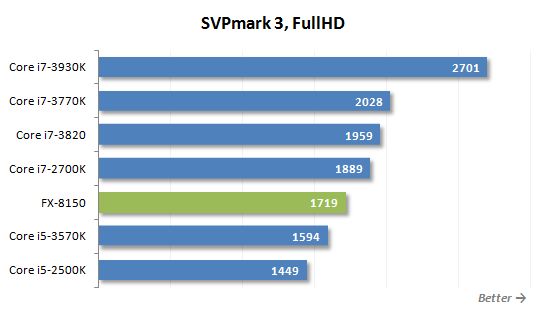
Here is another result that fits the overall picture perfectly. The Core i7-3770K is at the top of the diagram, being only inferior to the six-core LGA2011 processor. In other words, the senior model of the Ivy Bridge series is one of the fastest quad-core CPUs available today.
We will test computational performance and rendering speeds in Autodesk 3ds max 2011 using the special SPECapc for 3ds max 2011 benchmark:
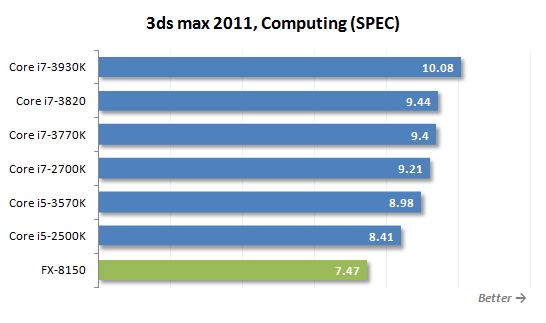
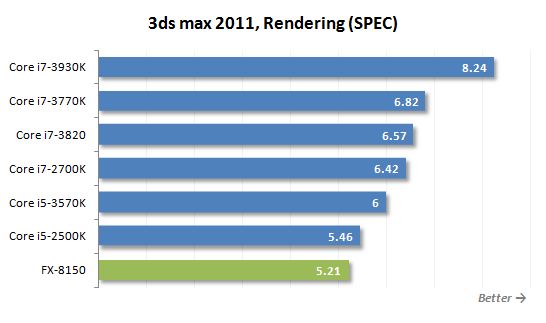
The new CPUs deliver high performance in workstation applications but the difference between the Core i7-3770K and Core i7-2700K, and between the Core i5-3570K and Core i5-2500K, is smaller than usual.
Another benchmark measuring the final rendering speed in 3D modeling suites was run in Blender 2.6.
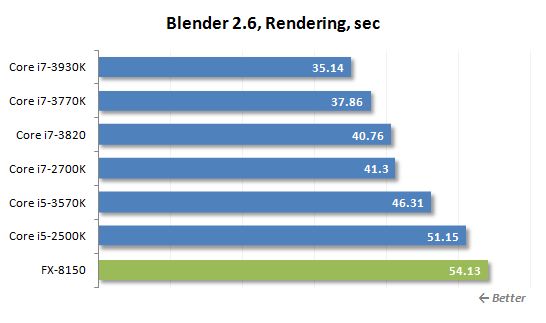
When rendering in Blender, the Core i7-3770K is 9% ahead of the Core i7-2700K. The Core i5-3570K, in its turn, is 10% faster than the Core i5-2500K.
Having benchmarked the Ivy Bridge series in over 10 different applications, we can say that it’s always faster than the Sandy Bridge CPUs with the same specs. The advantage amounts to an average 6%.
Moreover, the Core i7-3770K is often superior to the Core i7-3820, a higher-class product for the LGA2011 platform, in applications that are not memory-intensive. In other words, the Core i7-3770K seems to have no worthy quad-core opponents in terms of computing performance.
Power Consumption
The small performance benefits of the new-generation CPUs might be expected but what about their energy efficiency?
There were rumors that Intel increased the TDP of the senior 22nm CPUs to 95 watts although had planned to set it at 77 watts. Intel representatives told us that it was just a rumor, though. The actual TDP of the new CPUs, including the Core i7-3770K, is indeed limited to 77 watts but 95 watts is written on their packaging in order to maintain the standard scale of 35/65/95 watts that many Intel partners have got used to. Thus, the Ivy Bridge series can be expected to consume about 20% less power compared to the 95-watt CPUs with the previous microarchitecture.
The graphs below (unless specified otherwise) show the full power draw of the computer (without the monitor) measured after the power supply. It is the total of the power consumption of all the system components. The PSU’s efficiency is not taken into account. The CPUs are loaded by running the 64-bit version of LinX 0.6.4-AVX utility. Moreover, we enabled Turbo mode and all power-saving technologies to correctly measure computer’s power draw in idle mode: C1E, C6 and Enhanced Intel SpeedStep.
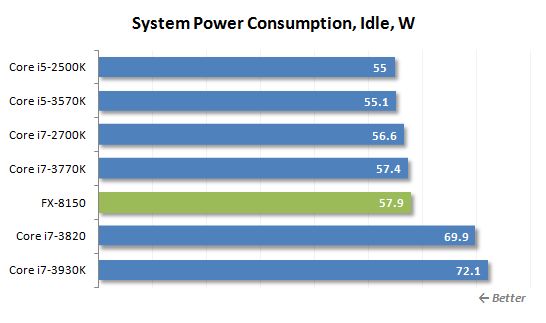
When idle, the Ivy Bridge systems consume about the same amount of power as the Sandy Bridge counterparts because the EIST technology sets their voltage at 0.9 volts, similar to the minimum voltage of Sandy Bridge CPUs. As a matter of fact, modern CPUs account for but a small share of the total power consumption of a computer when idle.
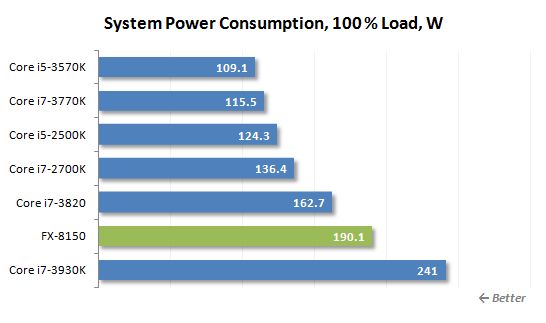
The benefits of the 22nm tech process and tri-gate transistors become apparent at full load. The Core i7-3770K consumes 20% less than the Core i7-2700K, while the difference between the Core i5-3570K and Core i5-2500K configurations amounts to 13%. Moreover, the senior quad-core Ivy Bridge is more economical than the Core i5-2500K! So, the new CPUs are indeed superior in energy efficiency. And we haven’t yet seen Ivy Bridge CPUs with reduced TDP!
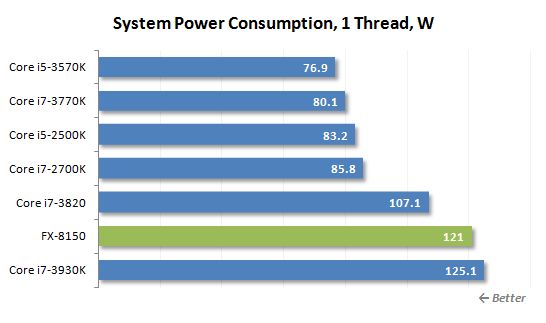
Testing power consumption at single-threaded load is interesting because modern CPUs enable turbo mode in this case, delivering higher performance while keeping the power consumption and heat dissipation within reasonable limits. The Core i7 3770K and Core i5-3570K turn out to be more economical than the Sandy Bridge in this test as well.
Thus, the Ivy Bridge series has no rivals in terms of performance per watt. And this seems to be its key advantage considering its overclocking potential which we’ll discuss below.
Ivy Bridge Overclocking
Computer enthusiasts usually believe that introduction of new manufacturing technologies should also improve the processors’ overclocking potential. In case of Ivy Bridge there are objective reasons to expect this: even the top CPUs in this family have lower power consumption, and the maximum temperature when thermal throttling kicks in increased to 105°C.
Moreover, there was also some hope that unlike their predecessors, Ivy Bridge processors could regain their ability to be overclocked by changing the base clock. However, there is no good news to report here: LGA 1155 platform requires unified clock frequency generator that shapes up the processor frequency together with the frequencies of the peripheral devices controllers and PCIe and DMI busses. So even with the newest Intel Z77 chipset any base clock deviation beyond the 105-107 MHz range causes a complete system failure.
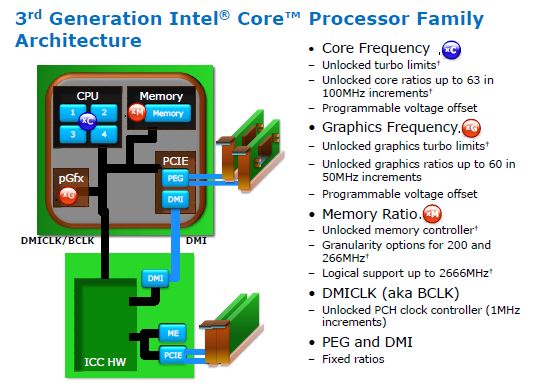
Therefore, just as before the only way to overclock Ivy Bridge processors is by changing the clock frequency multipliers. They have a total of three multipliers:
- Primary multiplier setting the frequency of the computational cored. It is fully unlocked in all K-series processors. All other processor models allow increasing it by four increments above the nominal.
- Graphics core frequency multiplier, which allows speeding up processor graphics core in 50 MHz increments. This multiplier is unlocked in all CPUs.
- Multiplier for the memory frequency. Ivy Bridge processors allow adjusting it in 200 MHz as well as 266 MHz increments, which allows using a vast variety of DDR3 modes.
There are not that many improvements over Sandy Bridge, but they are there indeed. The highest multiplier supported by K-series processors has increased to 63. Besides, it is now possible to overclock system memory in a much more flexible manner.
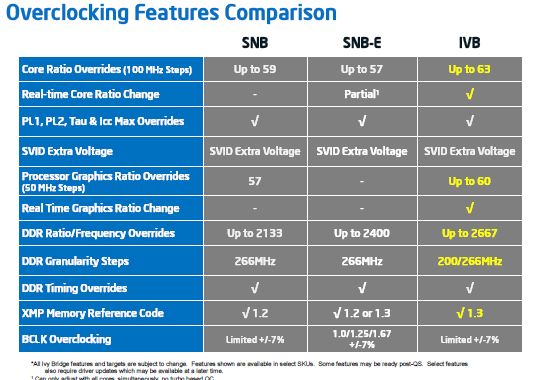
For example, this is what the list of supported DDR3 modes looks like for a typical LGA 1155 mainboard with an Ivy Bridge processor:
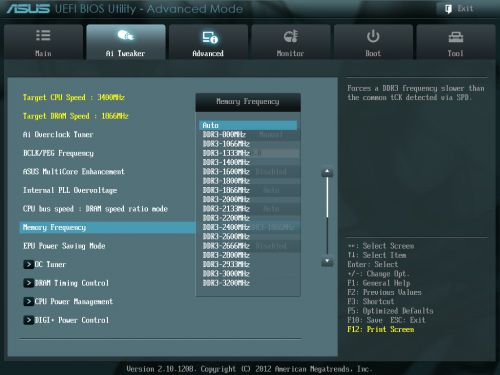
I have to say that the release of LGA 1155 platform has significantly simplified the overclocking process. Besides increasing the corresponding multipliers, all enthusiasts need to do is adjust a few voltages that affect the system overclocking potential.
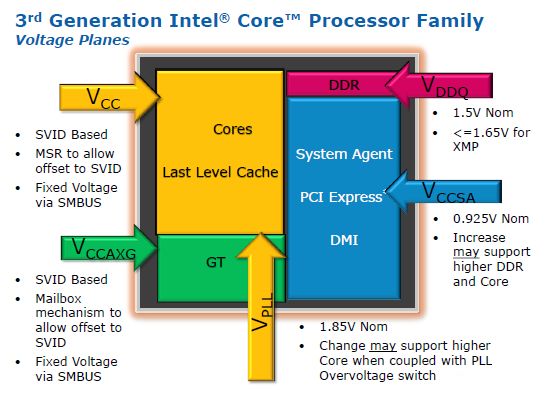
Ivy Bridge processors, just like Sandy Bridge, have five voltages like that:
- VCC – primary voltage of the processor computational cores. It directly affects the processor overclocking potential. For Ivy Bridge the nominal values are usually around 1.0 V or a little higher.
- VCCAXG – graphics core voltage. Increasing this voltage helps raise the frequency of the graphics core integrated into the processor.
- VPLL voltage. In most cases it doesn’t affect overclocking results, but comes in handy for setting overclocking records using extreme cooling methods.
- VCCSA – system agent voltage. The nominal value for this parameter in Ivy Bridge is set at 0.925 V. By raising this value you can stabilize the processor memory controller when higher memory frequencies are in place.
- VDDQ – memory voltage. Adjusting this voltage helps during memory overclocking, but you shouldn’t increase it beyond 1.65 V in order to avoid damaging the Intel processor.
Just like before, the only voltage, which pushes back the maximum stable CPU frequency, is the VCC. So theoretically, Ivy Bridge processors seem to be easy candidates to overclock.
Unfortunately, practical experiments uncover a few unpleasant issues. We tested two different Ivy Bridge processors in our lab, but none of them managed to achieve stability at the frequencies reached by their previous-generation predecessors. Using NZXT Havik 140 processor cooler we managed to overclock our Core i7-3770K processor only to 4.6 GHz.
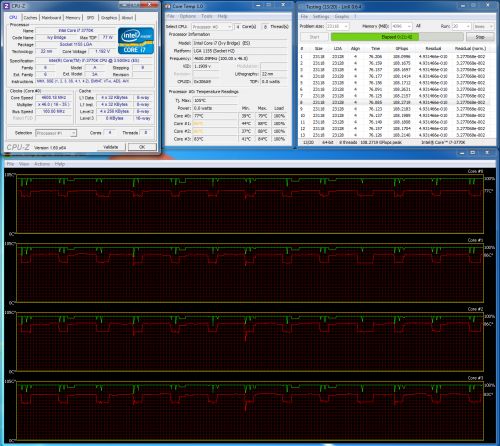
…while Core i5-3750K processor was operational only at 4.5 GHz.
In both cases the CPU Vcore was increased to 1.2 V and Load-Line Calibration parameter was set to Ultra-High. Just like with other processors, increasing this parameter has a positive effect on the overclocking potential. However, it is important to keep in mind that excessive voltage increase may cause CPU degradation and failure. Therefore, while there is no real statistics on Ivy Bridge processors manufactured using new 22 nm process, we would like to warn you against using too high VCC values. Considering that the nominal voltage of the new processors is somewhere in the vicinity of 1.0 V, long-term use even at 1.2 V may have serious consequences. Therefore, we decided to refrain from any overclocking experiments at higher voltage settings at this point.
In any case, the frequency potential of the new Ivy Bridge processors turned out to be below our expectations. We didn’t manage to overclock them even to the same heights as the previous-generation Sandy Bridge. So, we can state that the overclocking potential of the newcomers has become worse, which may have been caused by the reduction of the geometrical die size of the new Ivy Bridge. Its overall size is 25% smaller than the Sandy Bridge die, and the computational cores have become only half the size of the Sandy Bridge cores. However, contemporary approach to processor die cooling doesn’t allow increasing the heat flow density in equal proportion, which causes local overheating of some parts of the processor cores during overclocking. High operational CPU core frequencies indirectly confirm that this problem indeed exists, although the processor cooler remained practically cold in this case.
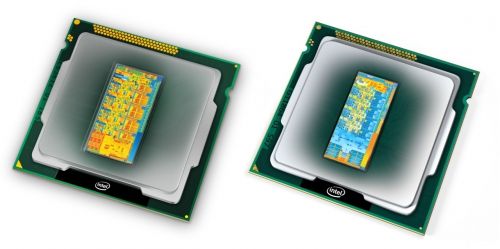
As a result, it looks like even after the launch of the new Ivy Bridge the title of the best enthusiast platform will go to LGA 2011. These processors not only boast additional features that allow overclocking them by simply raising the BCLK frequency, but also boast better overclocking potential. However, if the LGA 2011 platform seems financially out of reach, then the old Sandy Bridge processors may present a worthy alternative to Ivy Bridge. Especially, since they do not fall too far behind the newcomers working at the same clock speeds in computational performance.
Conclusion
No doubt, the new Ivy Bridge is an evolutionary step forward. Although no one promised any significant performance differences from the predecessors, Intel engineers managed to ensure a pretty significant, almost 10% performance gain compared with the previous-generation CPUs. Of course, it is achieved not only with microarchitectural improvements, but also with higher clock frequencies. But it is not a big deal, since the new third-generation Core processors aren’t any pricier than the Sandy Bridge products, which the new processors came to replace.
Moreover, Ivy Bridge offer substantially improved electrical and thermal parameters. Their energy-efficiency has got to a completely new level and allows lowering the power consumption of fully loaded contemporary LGA 1155 systems by about 20 W.
It is particularly nice that all these extras do not require any platform refresh, as the new processors can work just fine in old LGA 1155 mainboards purchased over a year ago. So, they will definitely make a great upgrade option. Moreover, by replacing just the CPU, the LGA 1155 platform will also acquire support for faster PCI Express 3.0 bus and extended DDR3 SDRAM frequency range.
I think all that should be enough to name Ivy Bridge a very successful update to the Intel processor family. Not to mention that they also offer new Intel HD 4000 graphics core. Unlike the graphics core integrated into the Sandy Bridge CPUs, this one supports DirectX 11, has GPGPU functionality and delivers good entry-level graphics performance.
It seems that Ivy Bridge should first of all become a great choice for mobile systems, as it was designed with them in mind in the first place. Therefore, most of its advantages may seem very niche from the desktop users’ perspective. However, even the desktop users will not find any serious reasons for complaining in this case.
The only user group who may be somewhat disappointed with the new Ivy Bridge is overclockers. The frequency potential of the new processors manufactured with the latest 22 nm process has suddenly turned out a little lower than that of the predecessors. That is why the third-generation Core CPU may not be a good fit for overclocked systems just yet. However, we expect things to get better. The improvement of the production process and release of the new processor steppings should push back the maximum frequencies for Ivy Bridge and make it enthusiast-friendly.